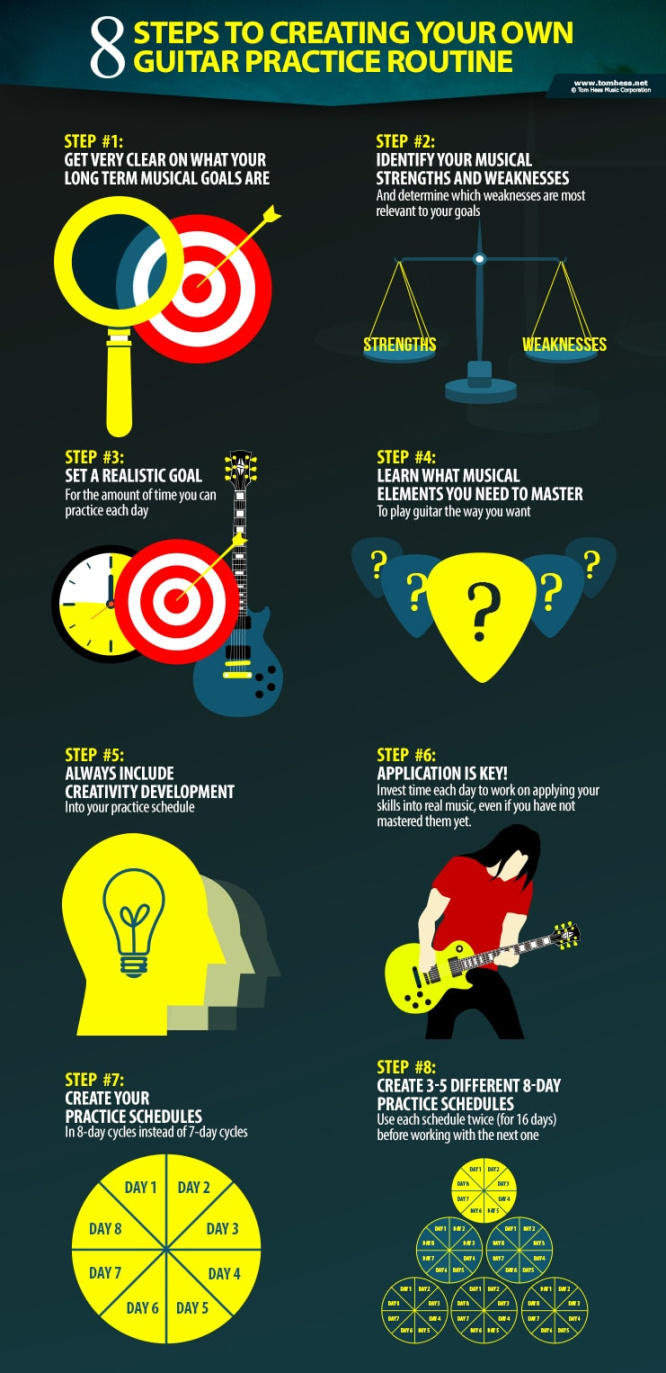—
Crafting Your Perfect Guitar Practice Schedule: A No-Nonsense Guide
So, you’ve got a guitar. Maybe it’s an old acoustic gathering dust, or a shiny new electric you’re itching to shred on. Either way, you know you need to practice. But where do you start? How much time should you dedicate? And what exactly should you be practicing? Let’s break down the often daunting task of creating a guitar practice schedule that actually works.
Why a Schedule Matters (Even if You Hate Schedules)

Look, we get it. Schedules can feel rigid and boring. But when it comes to learning guitar, a little structure goes a long way. Think of it like this: you wouldn’t try to build a house without a blueprint, right? A practice schedule is your musical blueprint. It helps you stay focused, track your progress, and avoid those frustrating plateaus.
Setting Realistic Goals: Start Small, Think Big
Before you dive into the nitty-gritty of your schedule, take a moment to consider your goals. Are you aiming to play campfire classics, write your own songs, or become the next guitar hero? Your goals will shape your practice routine.
Beginner Basics: If you’re just starting out, focus on the fundamentals. Chords, scales, and basic strumming patterns are your bread and butter.
Time Management: Finding Your Rhythm
Now, let’s talk time. How much should you practice? There’s no magic number, but consistency is key. Even 15-30 minutes of focused practice every day is more effective than a marathon session once a week.
The Daily Grind: Aim for daily practice, even if it’s just a short session. This helps build muscle memory and keeps your skills sharp.
What to Practice: A Breakdown of Essential Skills
Okay, so you’ve got your goals and your time. Now, what should you actually be practicing? Here’s a breakdown of essential skills to incorporate into your schedule:
Warm-Ups: Get Those Fingers Moving
Just like any athlete, you need to warm up before you start playing. Spend a few minutes on simple exercises, like scales, chromatic runs, and finger stretches. This will help prevent injuries and improve your dexterity.
Chords: The Foundation of Music
Chords are the building blocks of most songs. Start with basic open chords, like C, G, D, and A. Then, gradually introduce barre chords and more complex chord voicings.
Scales: Unlock the Secrets of Melody
Scales are essential for understanding melody and improvisation. Start with the major and minor scales, and then explore different modes and scales.
Rhythm and Strumming: Keep the Beat Alive
Rhythm is just as important as melody. Practice different strumming patterns, and work on your timing and groove. Use a metronome to keep your tempo consistent.
Technique: Refine Your Skills
Depending on your goals, you’ll want to focus on specific techniques, like fingerpicking, alternate picking, sweep picking, or tapping. Break down complex techniques into smaller, manageable steps.
Ear Training: Develop Your Musical Ear
Ear training is the ability to recognize and identify musical intervals, chords, and melodies. This skill is crucial for songwriting, improvisation, and playing by ear.
Song Learning: Apply Your Skills
Learning songs is a great way to apply your skills and expand your repertoire. Choose songs that you enjoy and that are appropriate for your skill level.
Theory: Understand the Music You Play
Music theory can seem daunting, but it’s essential for understanding how music works. Start with the basics, like key signatures, chord progressions, and scales.
Improvisation: Express Yourself Through Music
Improvisation is the art of creating music on the fly. Start by improvising over simple chord progressions, and gradually explore more complex harmonic landscapes.
Structuring Your Practice Sessions: A Sample Schedule
Here’s a sample practice schedule that you can adapt to your own needs:
Day 1: Chords and Rhythm
10 minutes: Warm-ups
Day 2: Scales and Technique
10 minutes: Warm-ups
Day 3: Song Learning and Ear Training
10 minutes: Warm-ups
Day 4: Theory and Improvisation
10 minutes: Warm-ups
Day 5: Review and Refinement
10 minutes: Warm-ups
Staying Motivated: Keep the Fire Burning
Learning guitar can be challenging at times. It’s important to stay motivated and keep the fire burning.
Set Achievable Goals: Break down your long-term goals into smaller, more manageable steps.
Conclusion: Your Musical Journey Awaits
Creating a guitar practice schedule is an investment in your musical journey. It’s a tool that will help you stay focused, track your progress, and ultimately achieve your goals. Remember, consistency is key. Even short, daily practice sessions are more effective than sporadic marathon sessions. Be patient, stay motivated, and enjoy the process. Your dedication will pay off, and you’ll be playing the tunes you love before you know it. Happy practicing!

